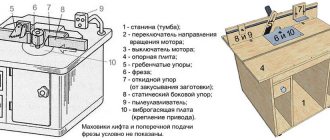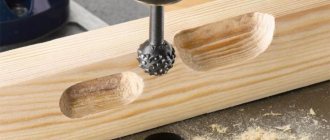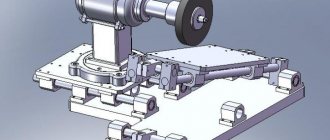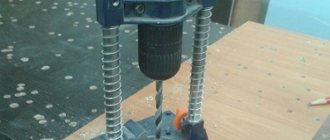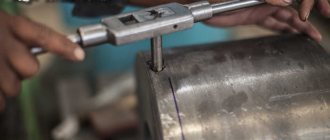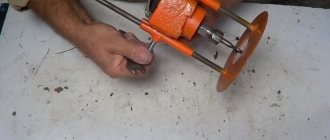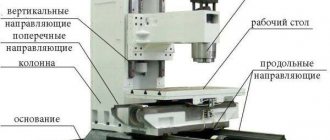A copy milling machine is used to produce parts of complex shapes. Using such equipment, molds, propeller blades, as well as metal castings and bending dies are made. The copying machine is developed on the basis of milling machines. If you need to copy a part made of wood or metal at enterprises, in small workshops and in production, copy-milling equipment is used. The main purpose of the units is to create parts that are as identical as possible to the original sample.
In large manufacturing enterprises and small workshops, there is often a need to create several identical parts according to one sample. To do this, they use equipment of this type, which makes it possible to produce identical parts in large batches, and in quality that is not inferior to the original sample.
Machine design
Copy milling machines are used to process workpieces by milling two types:
1 – planar – processing of profiles;
2 – volumetric – processing of surfaces with relief.
Milling cutters are used as a working tool, which, when processing a workpiece, exactly repeat the contour of the original part, repeating the movements of the copier. The working tool is driven, in the case of manually operated machines, using pneumatic, hydraulic and mechanical elements. These elements are necessary to generate the force from the copier to the working tool of the machine.
A flat contour or spatial model, contour drawings or a reference part is used as a template. The element that reads the shape and dimensions of the model is called a copying finger, roller, probe or photocell. The reference part and the workpiece being processed are placed on a rotating work table of a drilling and milling machine. The reference part is made of aluminum. Other metal, plastic or wood are also used.
The working body of the machine is driven by a screw, solenoid, spool valve, electromagnetic clutch or differential. In addition, special relays are used for amplification, which can be electro-optical, hydraulic or electromagnetic.
The actuator circuit of any model of drilling and milling machine consists of a hydraulic cylinder and an electric motor.
Some machine models are equipped with a pantograph - a device that ensures copying of a part to a given scale. Structurally, the unit consists of a guide pin, an axis, a tool spindle and an axis of rotation. The guide pin and spindle are mounted on the same rail. The copying scale is determined by the ratio of the arms of a given slatted frame.
The process of copying a part occurs as follows:
— the finger moves along the contour of the reference part and sets the rack in motion, which in turn rotates on an axis;
- on the other side of the rack, the spindle makes similar movements, thereby processing the workpiece.
Pantograph
The pantograph (Fig. 6) carries out a copying movement on the machine. Copying using a pantograph (articulated parallelogram) is based on the principle of geometric similarity of triangles and is carried out according to the scheme below;
Pantograph of engraving machine 6e463
Pantograph of engraving machine 6E463
Pantograph of engraving machine 6E463
Ш - spindle point
T - tracer point (palpating finger)
K, L, M and N are the hinge points of the pantograph.
This scheme allows copying with a large range of scales with relatively small dimensions of the sides of the parallelogram, as well as covering a fairly large service area.
The pantograph arms are connected to each other by hinges assembled on high-precision angular contact bearings I (Fig. 6). Using carriages 4 and 5, the pantograph is connected to the spindle body 4 and the stand 5. The connection is also made on high-precision angular contact ball bearings 13. The movable connections of the pantograph with the carriages are made in the form of a “dovetail”. Changing the pantograph gear ratio (copying scale) is done by moving the pantograph arms 6 and 7 relative to the carriages 2 and 3, followed by fixing them with handles 8 and 9.
The probing device (Fig. 7) is made in the form of a collet sleeve 1, inside which the tracer 2 moves. In the operating position of the device, when the tracer comes into contact with the profile of the character or copier letter being copied, the tracer is clamped with a handle-nut to move to another character or the copier letter, it is necessary to first release the handle-nut in order to allow tracer 2, under the action of spring 4, to leave contact with the profile of the copying template (copier).
The probing device can be installed at different heights (within 15 mm) by moving the collet sleeve I in the axial direction relative to the pantograph arm 14 (Fig. 6).
About other machines: Drilling machines 2A125 in Moscow - Equipment Exchange ProMachines
The stroke of the tracer 2, depending on the height of the profile of the copying sign or letter, is regulated by installing a rubber ring 5. The maximum stroke of the tracer (relative to the collet sleeve I) is 4 mm. In the operating position of the probing device, screw 15 (Rie.6) must be tightened. To set the copy scale to 1:1, it is necessary, in addition to installing the carriages, to install a probing device and the arm hole 14 located closer to the pantograph hinges (Fig. 6). For all other pantograph gear ratios (1:2, 1:3... 1:100), the probing device must be installed in the outermost hole of the arm 14 (Fig. 6). A detailed description of setting the pantograph to the required copying scales is given on pages 41 and 42.
Equipment classification
Depending on the type of drive used in the design, copy-milling equipment is divided into the following types:
- machines with a pantograph make it possible to process workpieces in two or three dimensions;
- machines with a copier, which is mounted on a rotary rack moving in a vertical plane;
- machines with multiple spindles, equipped with round or rectangular rotary tables;
- machines, the feed on which is ensured by mechanical, electrical, hydraulic devices;
- photocopying equipment.
In addition to this classification, equipment is divided according to the method of fixing the workpiece, as well as the degree of automation.
- Handheld or tabletop. In this case, the workpiece is fixed mechanically. Such machines allow you to drill holes of various shapes in accordance with the template.
- Standard automatic machines. The workpiece is fixed using pneumatic clamps. Such machines are used for processing aluminum workpieces.
- Stationary automatic machines with pneumatic clamps. This equipment is equipped with a head with three spindles. The machines make it possible to drill triple holes.
- Carousel type machines. Designed for wood processing in carpentry. Using such a machine, they make legs, backs, armrests and other curved parts of chairs. Productivity is more than 1000 parts per shift. It is also used in the manufacture of panels for doors and facades.
- Longitudinal milling copy machines. The machine is equipped with a carriage that moves between the milling and grinding elements.
Basics of the Milling Process
In almost all large industrial production and small workshops you can find milling machines. After all, milling is the most popular method of mechanical processing of products. Milling devices are used to perform rough, semi-finishing and finishing machining of workpieces made of wood, ferrous and non-ferrous metals, as well as plastic. Modern machines are capable of quickly and accurately processing products of not only simple, but also the most complex shapes.
Milling machines are divided into two types:
- General purpose machines.
- Specialized equipment.
The specialized equipment includes the copy milling cutters in question. They allow you to make copies of objects and work with both flat and three-dimensional shapes. Moreover, these devices can help to engrave, apply ornaments, various inscriptions, and create various patterns on edges that are located in different planes.
There are two milling methods:
- Counter, in which the tool is fed and rotated in different directions.
- Incidental. In this case, the feed and rotation of the tool occur in different directions.
The cutting blade of cutters of such machines can be made of a variety of materials, which allows you to successfully switch from processing wooden products to hard metals and even natural or artificial stones.
Application of copy milling machines
Copy-milling machines are designed to perform copying work in volume and on a plane. They are used when working with three-dimensional models and corresponding copiers, for engraving various shaped profiles, patterns, ornaments and inscriptions. The main advantage of the equipment is the production of complex patterns.
The machines are capable of processing steel, cast iron, and non-ferrous metals. High-speed and carbide tools are used for processing in large- and small-scale production. Copy-milling machines are used to produce propellers of ships, blades of turbojet engines and steam turbines, impellers of hydraulic turbines, cutting and forging dies, press and casting molds, stamps, molds, metal models and blanks.
The units are also used for drilling holes for handles, locks, latches, and metal hinges. In addition, it is possible to produce frames for mirrors and channels on plastic and aluminum profiles.
A copy-milling machine is used for milling curved parts. The use of templates eliminates the influence of the human factor. Moreover, all finished products have the same shape and parameters.
To accurately replicate a part, a pantograph is installed on a copy-milling machine. Its function is to accurately transmit the movement of the copy head along the profile of the cutting device. The use of this element makes it possible to produce several identical parts with high precision, which will be the same as the original sample.
Copier table
Copier table 10 (Pic.10) is designed for installing copiers used for processing. The copier table is installed on the pantograph stand 5. The table rotates 360° around the vertical axis manually. Setting the angle of rotation of the copier table is carried out using dial 11, fixing it with handle 12. The copier table is equipped with dovetail grooves, which are used to install the font. In addition, it has T-shaped slots that can be used to install various devices.
Specifications
The technical characteristics of copy-milling machines determine its functionality. Therefore, when choosing equipment, it is necessary to take into account the following technical parameters:
- dimensions and shape;
- weight;
- food type;
- the presence of numerical program control;
- desktop dimensions;
- electric motor power;
- number of spindles.
In addition, you can expand the functionality of the copier using additional components and elements, which include:
— rotating work table;
- rotary vice.
These elements make it possible to process workpieces at different angles.
Basic operations performed on machines
Copy-milling machines mill a metal workpiece by reading a given shape from a reference part using a copying tool. The milling device allows you to mill the surface of the workpiece. For the copier, a reference part is used, on the basis of which the device copies the contours onto the workpiece.
Copy-milling equipment is used for the following operations:
- creation of ornaments, curly inscriptions, patterns and contours;
- contour milling;
- surface engraving.
The equipment of the industrial group has wider capabilities and is used to create complex shapes and patterns on any plane.
How to choose a copy milling machine?
Before you buy a copy-milling device, you need to determine the list of necessary operations. Next, the optimal technical characteristics, as well as design features, are determined.
It is important to determine the main parameters that should be used when choosing a copy-milling machine model. First of all, you need to determine the dimensions of the device and the dimensions of the work table on which the workpieces are mounted and processed.
If the machine will not be used often, then it is not necessary to choose expensive branded equipment. Most budget models have the necessary number of functions. At the same time, they do not require large investments when purchasing, and are also inexpensive to maintain and operate. It is worth remembering that only industrial-grade equipment has a high level of performance and functionality. At the same time, a large amount of electricity is consumed.
It is also necessary to pay attention to the configuration and design features. This determines whether the device will be fully used. Modern models “out of the box” are equipped with the necessary components and devices that make the equipment of the copy-milling group multifunctional.
Manufacturers often limit the capabilities of equipment by not installing the necessary components and elements. In this case, before purchasing, you should make sure whether it is possible to purchase the necessary components from the same manufacturer. The use of non-original parts, assemblies or devices can lead to disruption of the entire machine, as well as to the occurrence of emergency situations.
